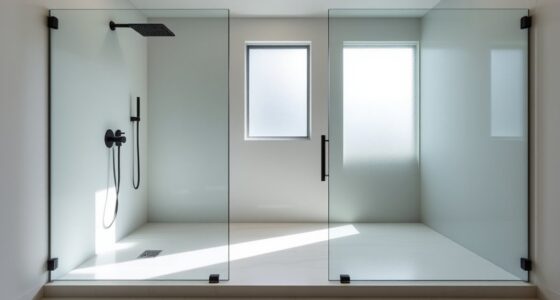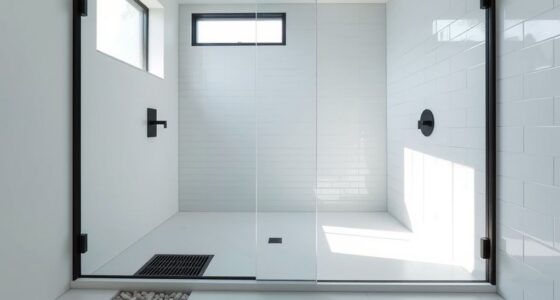To keep water flowing smoothly and avoid clogs, choose a shower drain that fits your shower size and design—such as point or linear drains. Make certain it has a proper slope toward the outlet and is installed correctly with the right sealant to prevent leaks. Picking the right material and type aids long-term durability. To avoid common mistakes and guarantee peak performance, pay attention to installation details—more tips are available to help you make the best choice.
Key Takeaways
- Select a drain type (point or linear) that suits your shower design for efficient water flow.
- Ensure the drain size matches your shower base to prevent fitting issues and water pooling.
- Install with proper slope (about 1/4 inch per foot) to guide water toward the drain and avoid standing water.
- Use waterproof sealants and double-check connections to prevent leaks and water damage.
- Regularly maintain and clean the drain to prevent clogs and ensure consistent drainage.

Selecting the right shower drain is essential for ensuring proper drainage and preventing water damage. When you choose a drain that’s suited to your shower’s size and design, you set the foundation for a leak-free, efficient setup. To do that effectively, you need to pay attention to installation tips that help avoid common mistakes that can lead to clogs or water pooling. First, measure your shower base carefully before purchasing a drain. Knowing the dimensions ensures you select a compatible drain size, reducing the risk of improper fitting. When installing, make sure the drain flange sits flush with the shower surface. An uneven or recessed flange can cause water to pool or seep into surrounding areas, leading to potential damage over time.
Choosing the right shower drain and ensuring proper installation prevents water pooling and damage.
One common mistake people make is neglecting proper slope during installation. The drain must be installed with a slight tilt toward the drain outlet, typically about 1/4 inch per foot. This slope guides water smoothly into the drain, preventing standing water and reducing the chance of mold or bacteria growth. Additionally, pay close attention to the sealant or gasket used during installation. A poor seal can cause leaks, which lead to water damage behind walls or under the shower pan. Use waterproof silicone or the recommended sealant to ensure a watertight fit, and double-check that all connections are tight but not overtightened, which could crack the drain or fittings.
Another area where mistakes happen is in the choice of the drain type. For example, choosing between a point drain or a linear drain depends on your shower design and flow requirements. Linear drains often require more precise installation but offer better water coverage, decreasing the likelihood of slow drainage. Meanwhile, some people forget to check compatibility with your shower base or tile thickness. Failing to do this can result in a drain that sits too high or too low, complicating installation and possibly causing water pooling.
Finally, remember that good drainage isn’t just about choosing the right product but also about proper installation. Always follow manufacturer instructions carefully, and don’t rush through the process. Taking your time to get the installation tips right will save you headaches later. Avoid common mistakes like skipping the slope, neglecting the seal, or choosing incompatible parts, and you’ll ensure your shower drain functions at its best for years to come. Proper planning and attention to detail make all the difference in keeping water flowing freely and preventing clogs or water damage down the line. Understanding how self-watering plant pots work can remind you of the importance of proper setup to maintain optimal function.
Frequently Asked Questions
How Often Should I Clean My Shower Drain?
You should clean your shower drain at least once a month to maintain good drain maintenance and prevent clogs. Regular cleaning removes hair, soap scum, and debris that can accumulate over time. If you notice slow drainage or odors, increase cleaning frequency. Using a drain cover helps catch debris and makes cleaning easier. Consistent maintenance guarantees water flows smoothly and keeps your shower fresh and clog-free.
Can I Install a Shower Drain Myself?
Imagine standing in your bathroom, holding a new shower drain like a puzzle piece waiting to fit. Yes, you can attempt DIY installation if you’re comfortable with plumbing basics, but don’t hesitate to seek professional assistance if unsure. Proper installation guarantees water flows smoothly and clogs stay away. While DIY can be satisfying, sometimes a professional’s expertise guarantees a seamless, long-lasting result, saving you headaches later.
What Materials Are Best for Preventing Clogs?
When considering what materials are best for preventing clogs, focus on those that promote good drain maintenance and have high material durability. Stainless steel and PVC are excellent choices because they resist corrosion and buildup, ensuring smooth water flow. Regular cleaning of your drain also helps prevent clogs. Avoid materials prone to debris buildup or corrosion, as they can compromise your drain’s efficiency and increase maintenance needs over time.
How Do I Fix a Slow-Draining Shower?
You might think a slow-draining shower is just a minor issue, but it’s often caused by buildup or debris. First, perform plumbing maintenance by removing and cleaning the drain cover choices to clear out hair and gunk. If it’s still slow, try a drain snake or a natural cleaner like baking soda and vinegar. Regular upkeep prevents future clogs, ensuring water flows smoothly and your shower stays functional.
Are There Eco-Friendly Shower Drain Options?
You’re wondering if eco-friendly shower drain options exist. Yes, they do! Look for drains made from eco-friendly materials like recycled metals or sustainable plastics. These options support sustainable plumbing practices and reduce environmental impact. Choosing environmentally conscious drains helps you lower your carbon footprint while maintaining effective water flow. So, you can enjoy a well-functioning shower drain that’s good for the planet, too.
Conclusion
So, after all this, you might think choosing the perfect shower drain is just a small detail. But ironically, it’s the one thing that keeps your bathroom running smoothly—literally. Skip it, and you’ll soon regret those clogged nightmares. So, don’t overlook the importance. Pick wisely, keep water flowing, and enjoy a clog-free shower experience. Because in the end, the tiniest drain might just be your bathroom’s biggest hero—or villain.










